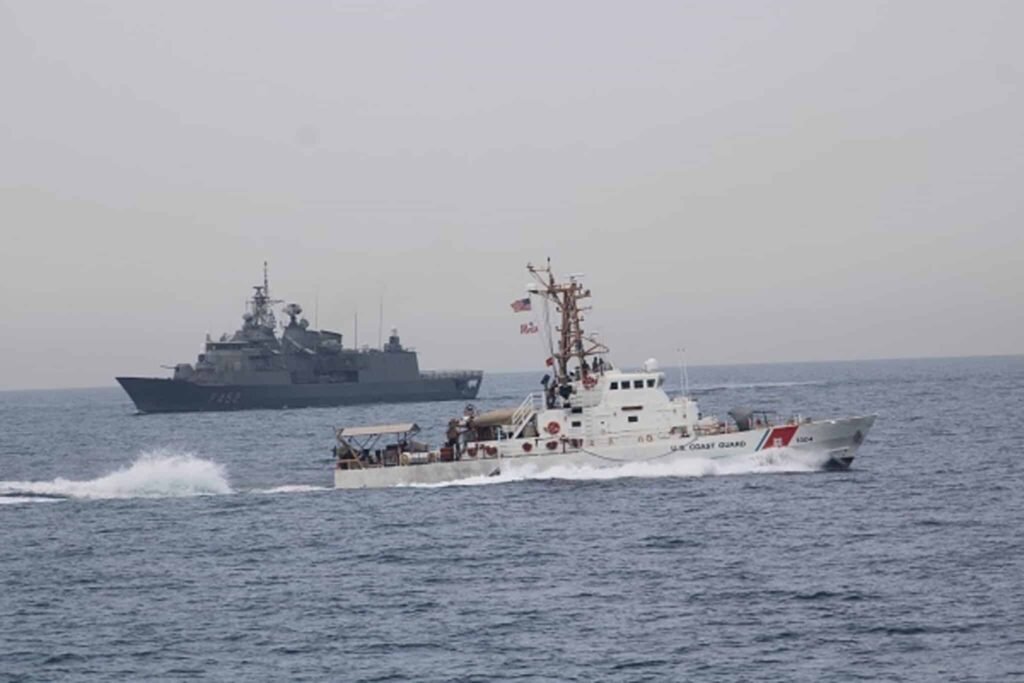
Greece Receives First Island Class Patrol Vessels From The U.S.
The first two of four former US Coast Guard Island-class cutters which are being transferred to the Hellenic Navy, have arrived in Perama, Greece.
On July 3, 2023 the first Island-class cutters, that were transferred to the Hellenic Navy by the United States Coast Guard (USCG), have arrived in Perama of Piraeus, Greece. Two more vessels will arrive in the coming weeks. The vessels were previously stationed in Manama, Bahrain (Naval Support Activity Bahrain) as a part of Patrol Forces Southwest Asia (PATFORSWA) to provide the US Navy 5th Fleet with combat ready assets. Regarding this development, Naval News has already reported that the four vessels were expected in 2023, in a detailed article about The Future of the Hellenic Navy Fleet.
Greece becomes the 6th country to acquire Island-class patrol vessels for its maritime forces, after Pakistan (Pakistan Maritime Security Agency), Georgia (Georgian Coast Guard), Costa Rica (Costa Rican Coast Guard), Ukraine (Ukrainian Navy) and of course the United States. In US service the vessels are gradually being replaced by the larger and more capable Sentinel-class (also known as Fast Response Cutters or Webber-class) cutters, a design (Stan Patrol 4708) from the Netherlands-based Damen Group.
The four Island-class ships will replace some very old coastal patrol vessels in service today. These are the Norwegian-built Nasty-class and French-built Antoniou-class. The first ones, Toxotis, Pigasos and Andromeda, are former torpedo boats which were acquired new in 1967. They were the first vessels built, post-war, by order of the Hellenic Navy and at the expense of the Greek Government. The four 533mm torpedo launchers have been removed since decades ago while the Napier Deltic engines have been replaced by two MTU 331 12V. Their speed therefore has been decreased from +40 kts to +20 kts. Their armament is one Bofors 40mm gun, one Oerlikon 20mm gun and two M1919 Browning 0.30 in machine guns. Their length overall is 24.5 meters while their displacement at full load exceeds the 75 tons.
The Antoniou-class, also known as Type 32 Esterel-class, are two 32-meter patrol vessels, Diopos Antoniou and Kelefstis Stamou, which were commissioned in 1975. Their armament consists of one Rheinmetall Mk 20 Rh-202, one M2HB 12.7mm heavy machine gun and two M1919 Browning 0.30 in machine guns. Both Nasty-class and Antoniou-class are wooden-hulled boats and quite obsolete.
The 110-foot Island-class patrol boats are a U.S. Coast Guard modification of a highly successful British-designed patrol boat from Vosper Thornycroft (UK) Ltd. They have excellent range and seakeeping capabilities. The four Island-class boats that will join soon the Greek naval fleet are the former Wrangell (WPB-1332), Adak (WPB-1333), Monomoy (WPB-1326) and Aquidneck (WPB-1309). Adak and Aquidneck were decommissioned on 15 June 2021 while Monomoy and Wrangell were decommissioned on 22 March 2022. The first two are those which arrived today afternoon in Greece.
It is almost certain that the Hellenic Navy will seek to acquire at least two more Islands in order to replace all of its obsolete coastal patrol vessels including the Nasty-class Kyknos, which was retired in 2021 after suffering damages following an accident near the island of Samos. Note that there were six USCG 110′ Island-class patrol boats assigned to PATFORSWA, those that are being transferred to Greece and two more boats, Maui (WPB 1304) and Baranof (WPB 1318). Maui was decommissioned on 22 March 2022 while the last Island cutter in Bahrain, Baranof, on 26 September 2022.
Their age is 32-37 years old. Their length is 34 meters, their beam 6.4 meters and their full load displacement around 170 tons. The powerplant consists of two Alco-Paxman Valenta 16CM diesel engines (5,820 bhp in total); their maximum speed is less than 27kt. The class is designed with a range of 2,890 nm and a five day endurance without replenishment. The crew consists of 16 men including two officers but there are accommodations for 18. The boats have a steel hull with aluminum deck and superstructure. In addition, they have a flush-deck with a round-bilge planing hull that is equipped with an active fin stabilization system. It is clear that, despite their age, the new boats are larger and by far more capable (armament, sensors, accommodations, technical characteristics) than those that are currently in service.
The ships will be moved to the Salamis Naval Base for security reasons and afterwards will be moved to a shipyard which the US government has selected for the refit and the partial modernization. As Naval News was first to reveal, some months ago, during DEFEA 2023 exhibition in Athens, the Island boats will receive a state-of-the-art 20mm remote weapon station (RWS), the LIONFISH 20 by Leonardo. The same system will consist the secondary gun armament of the three under-construction Kimon-class (FDI HN) frigates (two RWS each).
The transfer of the four Island-class boats will cost to the Greek government of around €39 million including transportation costs, a significant amount of spare parts, ammunition, equipment and upgrades. We believe that the RWS installation is not included in the package. The RWS will be integrated by the Americans. Further equipment such as surveillance radar, electro-optical sensor (Naval News verified that it will be a Miltech Hellas product), communications equipment and machine guns will be installed as well. The refit of the boats is expected to last at least 4 months.
Source: Naval News
Have a query? Contact Us
